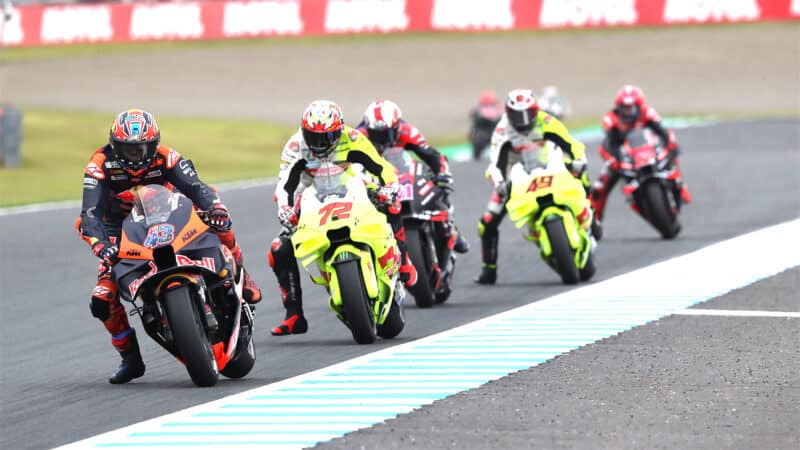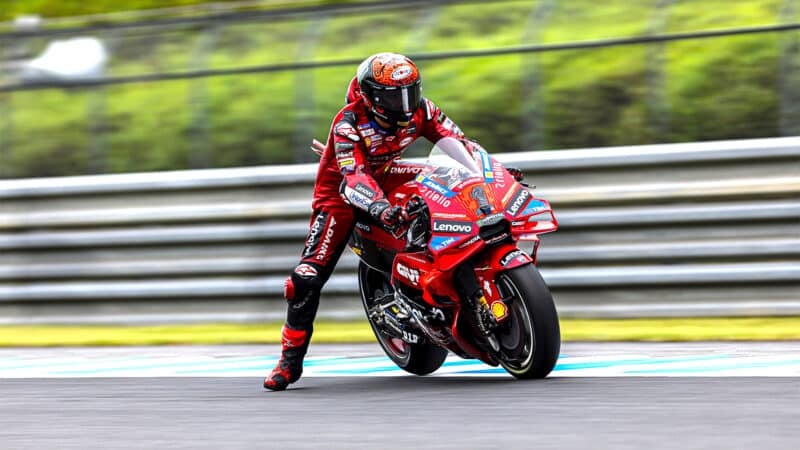But can the tyre really make such a difference?
“100%,” says Aprilia’s Aleix Espargaro. “We aren’t able to make the tyre work as we want. As soon as we push to arrive at the top lap time, we lose rear grip quite easily.”
What about KTM?
“The big thing we’ve been struggling with since they brought that rear tyre is the front,” says Brad Binder. “We’ve lost a bit of turning and the more we push the more we lose the front. It’s on a real knife edge – it’s perfect, then it’s gone, so it’s a bit sketchy.”
This is the rear pushing the front – the new rear is so grippy that it shifts load to the rear of the bike during braking and acceleration, reducing front load and grip. It is a difficult issue to solve for everyone – the Ducatis may be fast but they’re also on a knife edge.
KTM is battling another nightmare with the tyre – chatter and vibration, caused by the tyre’s extra grip. The same problem affected Desmosedici riders at the start of the season, which is why Ducati didn’t fully dominate until engineers had exorcised the problem after the first few races. Since then Ducati has locked out 11 of the last 13 podiums, an all-time record.
“We’re still trying to fix the vibration now,” says KTM’s Jack Miller, whose vibration issues with his RC16 were caught on camera during the recent Japanese GP. “When you’ve got high grip it’s a real issue.”

One KTM, two Ducati GP23s and two Aprilias struggling to keep up with the GP24s at Motegi
Red Bull
So is the 2024 tyre really the problem?
“Definitely,” adds Miller. “The bike is very similar to last year’s, apart from the engine. The chassis is the same, the swingarm is pretty much the same. The bike was working really well at the end of last year and took a step back this year.”
But what about Pedro Acosta, with his second-place finishes at Aragon and Mandalika and his Motegi pole position?
Acosta has an otherworldly talent and the advantage of starting his MotoGP career with the new rear, so he’s not had to adapt his riding technique from the old tyre to the new tyre. But he is also on a knife edge, as his Motegi crashes proved.
So how come Ducati – its GP24 in particular – can make such good use of tyre?
Its Desmosedici has pretty much always produced the most horsepower on the grid, so the bike has always been rear-end focused, so its riders can maximise that engine advantage out of corners.
This is one reason Ducati suffered so badly during the Bridgestone spec-tyre period, from 2009 to 2015, when MotoGP’s rear slick was much worse than the front.
Gigi Dall’Igna confirmed this in 2018, when I asked him about how the Michelins had helped changed Ducati’s fortunes since the French company became MotoGP’s spec-tyre supplier in 2015. “It’s luck, honestly,” he replied.
Therefore, whenever Michelin improves rear grip, Ducati says thank you very much.

Honda, KTM and Yamaha have the same rear tyre as Ducati, but they can’t exploit its grip so well
Honda
This doesn’t only concern acceleration, it also concerns braking, because Michelin’s rear slick is so much better than its front (the opposite of the Bridgestones), that riders need to use the fatter, grippier rear tyre to help stop the bike.






